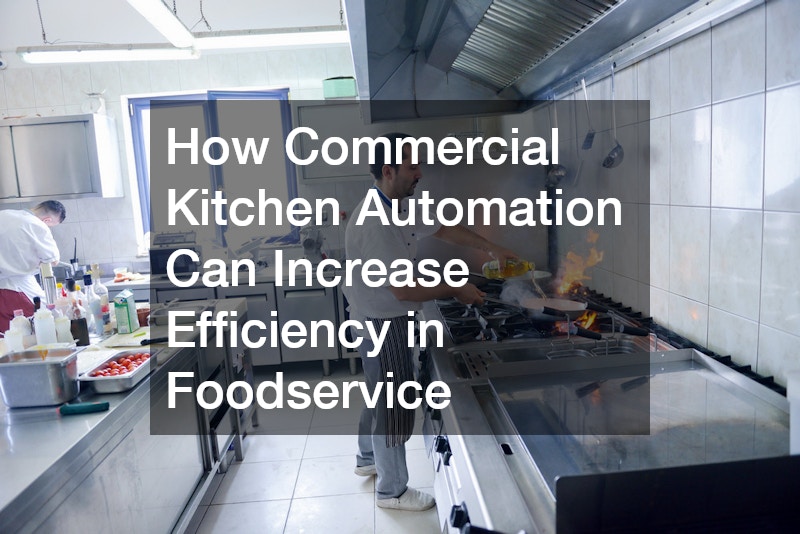The realm of foodservice is being steadily transformed by the integration of automation, which promises to elevate efficiency levels while lowering operational costs. Contemporary technological advancements have infiltrated commercial kitchens, offering a glimpse into a future where manual tasks are augmented with automated precision. These transformations underscore technology’s imperative role in evolving the industry to meet growing consumer demands.
What are the Benefits of Kitchen Automation?
Automation has the potential to significantly enhance productivity in commercial kitchens by streamlining operations and minimizing the need for human intervention. With automated systems in place, chefs can focus on creativity and quality while repetitive and mundane tasks are handled by machines.
Furthermore, automated solutions help optimize resource utilization and reduce food waste by ensuring precise portion control and timely ordering of ingredients.
The strategic implementation of automation leads to efficient inventory management, as intelligent systems predict stock needs more accurately than manual processes. Integrated supply chain systems are crucial in reducing over-purchasing and under-utilization of resources, thereby cutting costs. Projects like smart fridges and waste tracking systems predict potential waste, allowing kitchen managers to intervene preemptively to curb inefficiencies.
Many kitchens face challenges with waste management, but automation technologies like waste sensors provide real-time data that can be used to drive down waste generation. For instance, advanced fryers and ovens can autonomously adjust cooking times and temperatures, minimizing the chance of overcooking and ensuring every dish is perfectly prepared. The move towards automation signifies a pivotal shift towards sustainability and resource optimization in the culinary industry.
Which Automation Technologies are Most Effective?
The scope of automation in commercial kitchens spans various technologies designed to streamline and improve operations. One of the most impactful tools is robotic kitchen arms that can undertake monotonous tasks such as flipping burgers or assembling salads. These robotic systems augment the speed of service and improve the accuracy with which tasks are performed, ensuring consistency in every order.
Another crucial technology that has widespread adoption is intelligent cooking systems, which use sensors and adaptive algorithms to adjust cooking processes. These systems ensure that food is cooked to precision, meeting exact texture and flavor profiles, which enhances the overall dining experience. Automated ordering systems have also proven significantly effective, offering seamless communication between front-of-house teams and the kitchen.
Kitchens have also benefited from the integration of self-cleaning appliances that use automation to maintain hygiene standards with minimal human intervention. These appliances minimize downtime and labor costs associated with cleaning, enabling kitchen staff to allocate time and effort to more value-adding activities. This confluence of technologies highlights the diverse applications of automation to achieve a more consistently efficient kitchen environment.
How Does Automation Affect Food Quality and Consistency?
Maintaining food quality and consistency in the culinary world is paramount, and automation plays a critical role in achieving these benchmarks. Automation introduces precision in cooking processes that is challenging to attain through manual efforts alone. Through uniform temperature control and timing, automated systems ensure that each dish adheres to the particularities of the recipe, maintaining consistent flavor and presentation across services.
Advanced robotics and conveyor belt-based cooking solutions guarantee that every item is cooked or prepared to exact specifications, enhancing the dining experience with reliable quality. These systems minimize human error and variance, common contributors to inconsistencies in foodservice establishments. In essence, automation fortifies the promise of delivering high-quality meals consistently, irrespective of volume or time constraints.
Consistency is further enhanced through automated documentation and recipe management systems, which provide clear guidelines and instructions accessible to all kitchen staff. As kitchens adopt more sophisticated solutions, the focus shifts from manual monitoring to ensuring that systems are calibrated and recipes are updated as needed. Integrating such technology bolsters confidence in foodservice operations, fostering customer loyalty through consistent quality.
What Are the Challenges in Implementing Kitchen Automation?

Implementing commercial kitchen automation is challenging, as transitioning from traditional methods to technologically driven processes can be complex. One significant barrier is the initial investment required, which can be prohibitive for small to medium-sized enterprises. The cost of acquiring, installing, and maintaining sophisticated automated equipment can deter businesses despite the long-term benefits.
Another challenge is the resistance to change, as staff may be apprehensive about adapting to new technologies or fear job displacement. Training programs and transparent communication are essential in ensuring all team members feel secure and fully equipped to leverage the new systems effectively. Moreover, businesses must navigate software and hardware compatibility issues, ensuring that all systems can integrate seamlessly without disruptions.
Strategically overcoming these barriers is crucial, and it often involves a clear demonstration of the benefits and return on investment that automation can provide. Tailored training sessions, gradual implementation, and incremental updates to existing processes help ease the transition and mitigate resistance. As automation becomes more widespread, overcoming these challenges will set a new standard for operational excellence in the foodservice industry.
The advent of automation in commercial kitchens heralds a new era in the foodservice industry, characterized by increased efficiency, reduced waste, and enhanced food quality. While challenges exist, the long-term benefits of embracing technology are substantial, offering businesses the opportunity to survive and thrive in an evolving market. Integrating automation, the foodservice industry is on a path towards sustainable excellence, propelled by innovation and precision.

